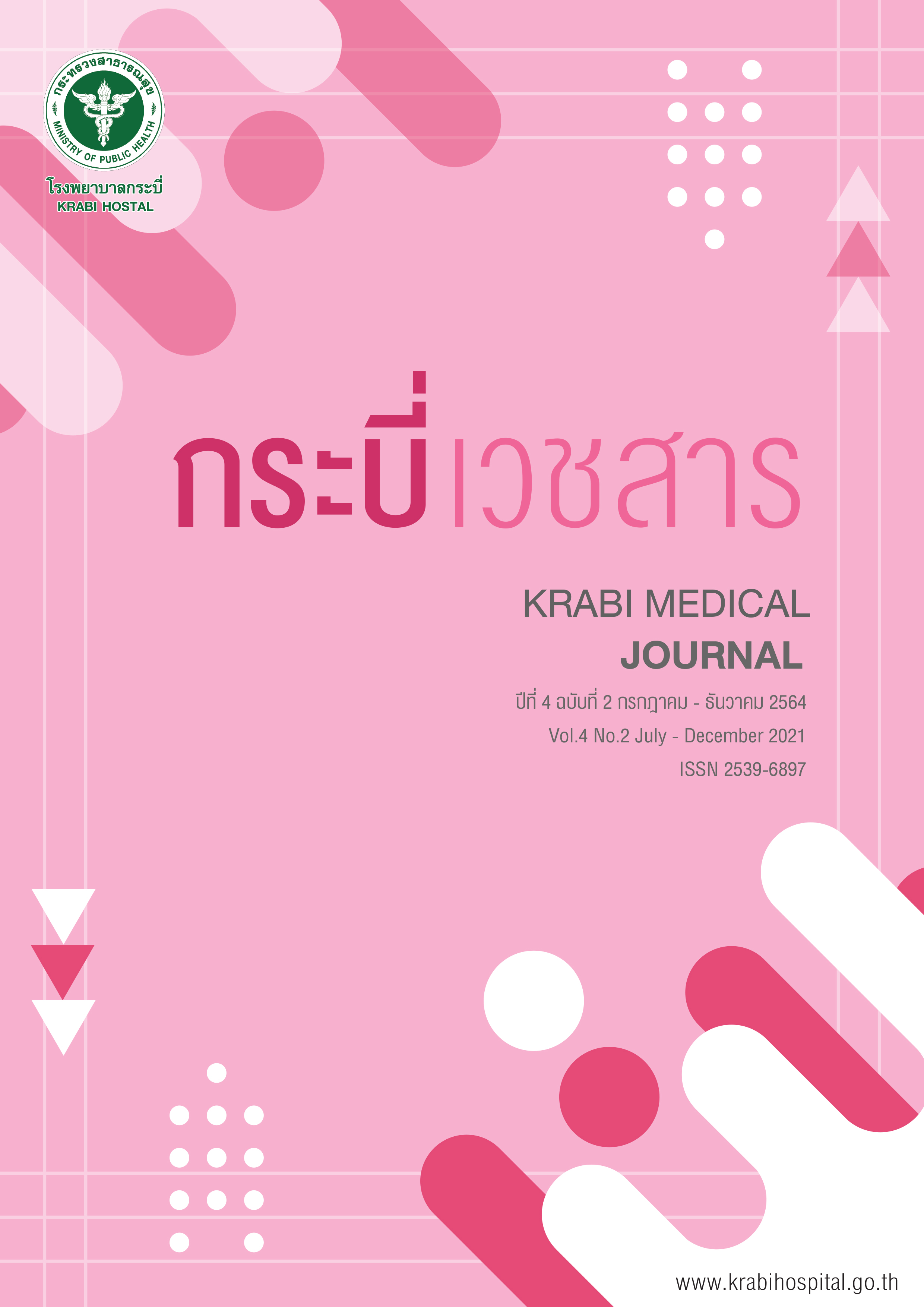การศึกษาเปรียบเทียบ ผลการรักษาโดยการผ่าตัดยึดตรึงกระดูกหักชนิดมั่นคง บริเวณอินเตอร์โทรแคน เทอริกด้วยแกนดามกระดูกProximal Femoral Nail Antirotation กับ Dynamic hip screw ในโรงพยาบาลกระบี่
Main Article Content
บทคัดย่อ
การศึกษาครั้งนี้เป็นการวิจัยเชิงพรรณนา มีวัตถุประสงค์เพื่อเปรียบเทียบผลการรักษาโดยการผ่าตัดยึดตรึงกระดูกหักและปัจจัยด้านต่างๆ เช่น ระยะเวลาผ่าตัด ปริมาณการเสียเลือด การผ่าตัดซ้ำและภาวะแทรกซ้อนหลังผ่าตัด ในกลุ่มผู้ป่วยผ่าตัดยึดตรึงกระดูกหักด้วยProximal Femoral Nail Antirotation (PFNA) และกลุ่มผู้ป่วยผ่าตัดแบบ Dynamic hip screw (DHS)
กลุ่มตัวอย่างที่ใช้ คือ ผู้ป่วยกระดูกต้นขาบริเวณสะโพกหักผ่านแนวปุ่มกระดูกที่หักแบบมั่นคงทุกรายโดยผู้วิจัยเป็นผู้ทำผ่าตัด ของผู้ป่วยทั้งสองกลุ่มในโรงพยาบาลกระบี่ เครื่องมือที่ใช้ในการศึกษาประกอบด้วยข้อมูลจากแฟ้มเวชระเบียน ฟิล์มเอกซเรย์ และผู้วิจัยจัดทำแบบบันทึกข้อมูลผู้ป่วยโดยทบทวนวรรณกรรมให้สอดคล้องกับตัวแปรที่ต้องการศึกษา วิเคราะห์ข้อมูลโดยใช้สถิติ สถิติเชิงพรรณนา สถิติในการเปรียบเทียบตัวแปรไม่ต่อเนื่องใช้ Chi-square test และ สถิติถดถอยเชิงเส้นแบบหลายตัวแปร(multiple linear regression) ในกรณีที่ตัวแปรต้นมีระดับความแตกต่างกัน
ผลการวิจัย: จำนวนผู้ป่วยกลุ่มตัวอย่าง 39 ราย แบ่งเป็นกลุ่มที่รักษาผ่าตัดแบบ DHS จำนวน 23 ราย กลุ่มที่รักษาผ่าตัด แบบ PFNA จำนวน 16 ราย พบว่าผู้ป่วยทั้ง 2กลุ่ม มีปัจจัยที่ใกล้เคียงกัน เช่น ส่วนใหญ่เพศชาย ผู้สูงอายุ อายุช่วง 60-70 ปี ไม่มีอาชีพ ASA classระดับ 3 สาเหตุของการหักของกระดูกเกิดจากการหกล้ม การหักของกระดูกต้นขาบริเวณสะโพกหักผ่านแนวปุ่มกระดูกที่หักแบบมั่นคง
สรุปการศึกษาวิจัยครั้งนี้เมื่อเปรียบเทียบกับผ่าตัดยึดตรึงกระดูกหักด้วยProximal Femoral Nail Antirotation (PFNA) และ Dynamic hip screw (DHS) ของโรงพยาบาลกระบี่ ปัจจัยที่เป็นตัวแปรตามของการผ่าตัดทั้ง 2 กลุ่ม พบว่าการเสียเลือดระหว่างการผ่าตัด ขนาดแผลผ่าตัด และระยะเวลาในการนอนโรงพยาบาล ของกลุ่มที่รักษาผ่าตัด PFNA มีค่าน้อยกว่าอย่างมีนัยสำคัญทางสถิติ ส่วนผลของการรักษาในด้านระยะเวลาที่กระดูกติด (healing time) และภาวะแทรกซ้อนหลังผ่าตัด มีค่าใกล้เคียงกันทั้งสองกลุ่ม เมื่อนำข้อมูลที่มีค่าความแตกต่างมาวิเคราะห์ข้อมูลโดยใช้สถิติถดถอยเชิงเส้นแบบหลายตัวแปร พบความแตกต่างของสองปัจจัย คือ การสูญเสียเลือดขณะผ่าตัด มีค่า p =0.025 และ ขนาดของแผลผ่าตัด มีค่าp < 0.001 ส่วนปัจจัยที่เป็นระยะเวลาผ่าตัด,วันนอนโรงพยาบาล,ภาวะแทรกซ้อนหลังผ่าตัด,ระดับความเจ็บปวดและระยะเวลาการติดของกระดูกไม่มีความแตกต่างกันของการผ่าตัดทั้ง 2 ชนิด
Article Details

อนุญาตภายใต้เงื่อนไข Creative Commons Attribution-NonCommercial-NoDerivatives 4.0 International License.
บทความนิพนธ์ต้นฉบับจะต้องผ่านการพิจารณาโดยผู้ทรงคุณวุฒิที่เชี่ยวชาญอย่างน้อย 2 ท่าน แบบผู้ทรงคุณวุฒิ และผู้แต่งไม่ทราบชื่อกันและกัน (double-blind review) และการตีพิมพ์บทความซ้ำต้องได้รับการอนุญาตจากกองบรรณาธิการเป็นลายลักษณ์อักษร
ลิขสิทธิ์
ห้ามนำข้อความทั้งหมดหรือบางส่วนไปพิมพ์ เว้นว่าได้รับอนุญาตจากโรงพยาบาลเป็นลายลักษณ์อักษร
ความรับผิดชอบ
เนื้อหาต้นฉบับที่ปรากฏในวารสารเป็นความรับผิดชอบของผู้เขียน ทั้งนี้ไม่รวมความผิดพลาดอันเกิดจากเทคนิคการพิมพ์
เอกสารอ้างอิง
กระทรวงสาธารณสุข กรมควบคุมโรค สำนักโรคไม่ติดต่อ. ข้อมูลสถิติการตาย/ป่วยดูทั้งหมดจำนวนและอัตราผู้ป่วยใน ปี 2559 – 2561. [อินเทอร์เน็ต].2563. [เข้าถึงเมื่อ วันที่ 20 มิถุนายน 2564]
เข้าถึงได้จาก:http://www.thaincd.com/2016/mission
มูลนิธิโรคกระดูกพรุนแห่งประเทศไทย. แนวทางเวชปฏิบัติสำหรับโรคกระดูกพรุน 2553.
[อินเทอร์เน็ต]. 2553. [เข้าถึงเมื่อ วันที่ 20 มิถุนายน 2564] เข้าถึงได้จาก: http://www.topf.or.th/ckfinder/userfiles/files/topf_pdf/cpg53_th04.pdf
วรรณี สัตยวิวัฒน์.การพยาบาลผู้ป่วยกระดูกหักที่ได้รับการยึดตรึงด้วยวัสดุภายในร่างกาย. พิมพ์ครั้ง
ที่ 3. เชียงใหม่ : โครงการตำรา คณะพยาบาลศาสตร์ มหาวิทยาลัยเชียงใหม่. 2553.
กรีช ธีรลีกุล. การศึกษาเปรียบเทียบผลการรักษาโดยการผ่าตัดใส่เหล้กยึดกระดูกต้นขาบริเวณ
สะโพกหักผ่านแนวปุ่มกระดูกชนิดมั่นคงระหว่างแผ่นโลหะยึดตรึงกระดูกแบบเกลี่ยวล็อคกับไดนามิกฮิพสกรูใน
โรงพยาบาลศรีสะเกษ. ว.การแพทย์โรงพยาบาลอุดรธานี 2562;25(2):199-209.
ชาญยุทธ ศุภชาติวงศ์. กระดูกหักและข้อเคลื่อนที่สะโพกและต้นขา (Fracture and dislocation of the Hip and fracture femur). ใน: วิวัฒน์ วจนะวิศิษฐ, ภัทรวัณย์ วรธนารัตน์, ชูศักดิ กิจคุณาเสถียร, สุกิจ เลาหเจริญ ์สมบัติ, สรศักดิ ศุภผล. บรรณาธิการ. ออร์โธปิดิกส์. พิมพ์ครั้งที่ 3. กรุงเทพฯ: โฮลิสติกพับลิชชิ่ง; 2550. หน้า 165-80.
David G. Lavelle. Fracture and dislocation of the hip. In: Canale ST, Beaty JH,
editors. Campbell's operative orthopaedics. 11th ed. Philadelphia: Mosby; 2008. p. 3237-308.
John Keating. Femoral neck fracture. In: Bucholz RW, Heckman JD, Court-Brown CM,
Tornetta P,editors. Rockwood and Green's fractures in adults. 7th ed. Philadelphia:
Lippincott Williams &Wilkins 2010 ;1562-598.


